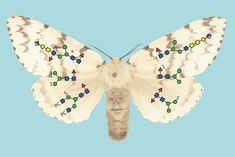The underestimated N-glycomes of lepidopteran species
Insects are significant to the environment, agriculture, health and biotechnology. Many of these aspects display some relationship to glycosylation. For a long time insect glycosylation was considered to be rather similar and simple, but more in-depth studies show structural diversity and interspecies variability.
In a new study, published in the April 2017 issue of ‘Biochimica et Biophysica Acta (BBA)‘, chromatographic and mass spectrometric methods were used to glycomically analyse two lepidopteran species (the cabbage looper Trichoplusia ni and the gypsy moth Lymantria dispar) as well as the commonly used T. ni High Five cell line. Thereby around 5% anionic N-glycan species, decorated with sulphate and glucuronic acid were detected, some also carrying the zwitterion phosphorylcholine. This degree of modification and variability is not only of evolutionary interest, but is of biotechnological relevance as lepidopteran cell lines are potential factories for recombinant glycoprotein production.
Link to the study: doi.org/10.1016/j.bbagen.2017.01.009

